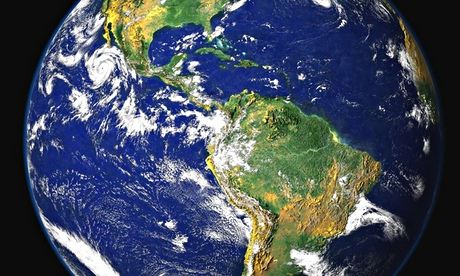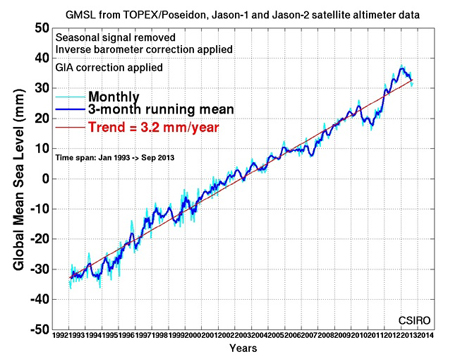The 'pause' in global warming is not even a thing -- All signs point to an acceleration of human-caused climate change. So why all this talk of a pause?
by Graham Readfearn, "Planet Oz," The Guardian, February 11, 2014
The IPCC in 2013 pointed out that more than 90% of the world?s extra heat is being soaked up by the oceans, rather than lingering on the surface. Photograph: Universal History Archive/Getty Images
The idea that global warming has "paused" or is currently chillaxing in a comfy chair with the words "hiatus" written on it has been getting a good run in the media of late.
Much of this is down to a new study analysing why one single measure ofclimate change – the temperatures on the surface averaged out across the entire globe – might not have been rising quite so quickly as some thought they might.
But here's the thing.
There never was a "pause" in global warming or climate change. For practical purposes, the so-called "pause" in global warming is not even a thing.
The study in question was led by Professor Matt England at the University of New South Wales Climate Change Research Centre.
England's study found that climate models had not been geared to account for the current two decade-long period of strong trade winds in the Pacific.
Once the researchers added this missing windy ingredient to the climate models, the surface temperatures predicted by the models more closely matched the observations – that is, the actual temperature measurements that have been taken around the globe. England explains the study in this YouTube video.
England told me:
Global warming has not stopped. People should understand that the planet is a closed system. As we increase our emissions of greenhouse gases, the fundamental thermal dynamics tells us we have added heat into the system. Once it's trapped, it can go to a myriad of places – land surface, oceans, ice shelves, ice sheets, glaciers for example.
England explained how the winds help the ocean to absorb heat into the thermocline – that's roughly the area between 100 metres and 300 metres deep. He says once the trade winds drop – which is likely to come within years rather than decades – then the averaged surface temperatures will rise sharply again.
Media outlets across the world have extensively covered England's paper. National Geographic told us the study revealed how the heat had been "hiding" in the oceans.
Over at the ABC, we were told the paper gave an explanation for "a pause in global warming" and that "over the past 15 years the rate of global warming has slowed - and more recently almost stalled."
On The Conversation, we had "Global warming stalled by strong winds driving heat into oceans."
Even though these reports spoke in detail about the complexity of the research (England feels the coverage generally has been very good), they could inadvertently cement the idea that global warming has in some way stopped, when it hasn't.
But this is almost unavoidable. You can hardly blame journalists and commentators for repeating the phrase that "global warming is in a hiatus" when the offending word is in the title of the scientific paper itself (Recent intensification of wind-driven circulation in the Pacific and the ongoing warming hiatus).
Andrew Bolt, News Corporation Australia's in-house climate science mangler,could not hide his excitement that Professor England apparently now "admits" that global warming has stopped.
Yet when it's all put into context, practically all the signs show the impacts of human-caused climate change are trending dramatically in the wrong direction – just as they have been for several decades.
Sea Level Rise
When the salty water of the oceans heats up, it expands, pushing sea level higher. If ice that's attached to land – such as the two major ice sheets in Greenland and Antarctica – melt, they also add to the water in the ocean, further pushing up sea levels. Melting glaciers also add to sea level rise.
So what's been happening while global warming was apparently having a holiday?
Here's a chart from Australia's CSIRO science agency showing sea level rise in recent decades. The drop you can see around 2011 was actually down to water being temporarily stored on the Australian land mass following the major flooding and rainfall event that year.

Global sea level continues to rise, driven by melting ice sheets, glaciers and warming and expanding oceans. Image: CSIRO
Melting cryosphere
The cryosphere – the Earth's icey areas – obviously don't think much of the notion that global warming might have stopped.
A study last year in the journal Science looked at glaciers in all regions of the world. The study found that the world's glaciers were melting at a rate of 259 billion tonnes a year between 2003 and 2009.
What about the ice sheets in Antarctica and Greenland, which together hold about 99% of the world's fresh water?
Between 1992 and 2001, ice was melting from the two main ice sheets at a rate of about 64 billion tonnes a year, according to the latest IPCC assessment of the science.
From 2002 to 2011, the ice sheets were melting at a rate of about 362 billion tonnes a year – an almost six-fold increase. What was that about a pause in global warming?
Climate change impacts
People suffering in extreme heatwaves, droughts and flooding, I would argue, don't stand there muttering: "At least the average global temperature on the earth's surface is 0.2 C less than some climate models thought it would be."
During this lovely comfortable hiatus when we're told by some that global warming has stopped and so we can all stop being such worry pots, what else has been going on?
Australia has experienced its hottest year on record after the most widespread heat wave on record. The risk of bushfires is on the rise.
The UK is experiencing extreme flooding – again.
Even if we do want to look at globally averaged temperatures, the "hiatus" has given the world its hottest decade since records began in 1850.
We could go on and on.
Not so much a "pause" as a "fast forward"
A decade ago, the world was talking about limiting the rise in global temperatures to 2C to avoid dangerous impacts from climate change.
Now, during a time when we are supposed to have been in a "hiatus", almost nobody thinks that guardrail is achievable.
Now, the talk is of 3C or 4C or higher.
Temperatures on the surface - measured by thermometers and then averaged out across the world - is not the problem defense agencies around the world fear could destabilize entire regions.
So what really caused the pause in global warming? I think there might be four possibilities.
1. Was it headline writers and journalists who, out of necessity, sometimes need to strip nuance and context from their stories?
2. Was it climate science deniers who repeated the "no global warming" mantra so often it started to infect even the rational people?
3. Was it the internet?
4. Was it a crack squad of fairies who secretly changed the laws of physics so the earth doesn't warm after you have pumped 1,407 billion tonnes of carbon dioxide into the atmosphere since the start of the industrial revolution?
Nah! While some thought climate change was on "pause" the reality is that the world's big fat fingers have been stuck on the fast-forward button.







No comments:
Post a Comment